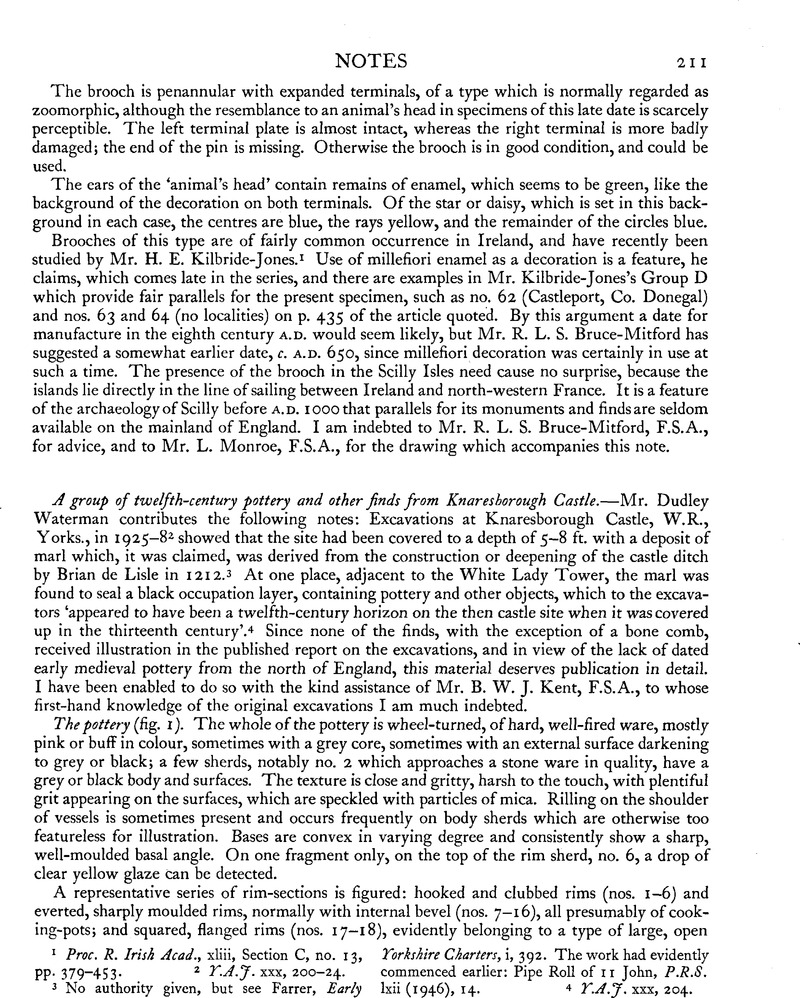No CrossRef data available.
Article contents
A group of twelfth-century pottery and other finds from Knaresborough Castle
Published online by Cambridge University Press: 29 November 2011
Abstract

- Type
- Notes
- Information
- Copyright
- Copyright © The Society of Antiquaries of London 1953
References
page 211 note 2 T.A.J. xxx, 200-24.
page 211 note 3 No authority given, but see Farrer, , Early Yorkshire Charters, i, 392Google Scholar. The work had evidently commenced earlier: Pipe Roll of ii John, , P.R.S. lxii (1946), 14Google Scholar.
page 211 note 4 Y.A.J. xxx, 204.
page 212 note 1 P.S.J.S. xlviii (1913-1914), 20–21, fig. 4Google Scholar.
page 213 note 1 Thoresby Soc Pub. (1952), 20, fig. 6, 1Google Scholar.
page 213 note 2 Ibid., 23, fig. 6, 2, 6-8.
page 213 note 3 Ibid., 23, fig. 6, 3, 5.
page 213 note 4 Yorkshire Museum, York, unpublished.
page 213 note 5 In possession of Mr. B. W. J. Kent.
page 213 note 6 Yorkshire Museum, York.
page 213 note 7 Yorkshire Museum, York, unpublished.
page 213 note 8 P.S.A.S. lii (1917–1918), 67, fig. 2Google Scholar.
page 213 note 9 P.S.A.S. lvi (1922), 30, fig. 4, 3Google Scholar.
page 213 note 10 U.J.A., xv, 113, fig. 6.
page 213 note 11 London Museum Medieval Catalogue, 112–15.
page 213 note 12 A petrographical examination of the whetstone, together with other Yorkshire examples, was carried out by Mrs. J. E. Morey and Prof. K. C. Dunham at the Geological Survey and Museum; their full report will appear in Proc. Torks. Geol. Soc, forthcoming. The Knaresborough whetstone was included in a list of mica-schist hones published by Mr. Dunning, G. C. in Rep. Research Comm. no. xv, 232Google Scholar, and there, on my information, erroneously attributed to thefilling of the castle ditch.
page 213 note 13 Y.A.J. xxx, pl. opp. p. 209.
page 213 note 14 Lethbridge, T. C., ‘Recent Excavations in Anglo-Saxon Cemeteries in Cambridgeshire and Suffolk’ (Camb. Antiq. Soc, Quarto Pub., N.S., no. 3, 1931), figs. 25, 1Google Scholar; 34; 36, 5. Similar combs have been found in seventh-century graves in Kent; Fausset, , Inventarium Sepukhrale, pl. XIII, 2–4Google Scholar.
page 213 note 15 The later development of combs, either single or double, has not been studied in this country, where datable material is lacking. For Sweden, however, there is Blomqvist's study, based on the extensive series from Lund (Museum, Kulturen, Arsbok (1942), 133–62)Google Scholar and in Norway, Grieg's treatment of the finds from Bergen and Oslo, (Middelalderske Byfund, 223–41)Google Scholar. Two single-edged combs have lately been found in late-thirteenth to early-fourteenth century deposits at Clough Castle, Co. Down: U.J.A., forthcoming.




